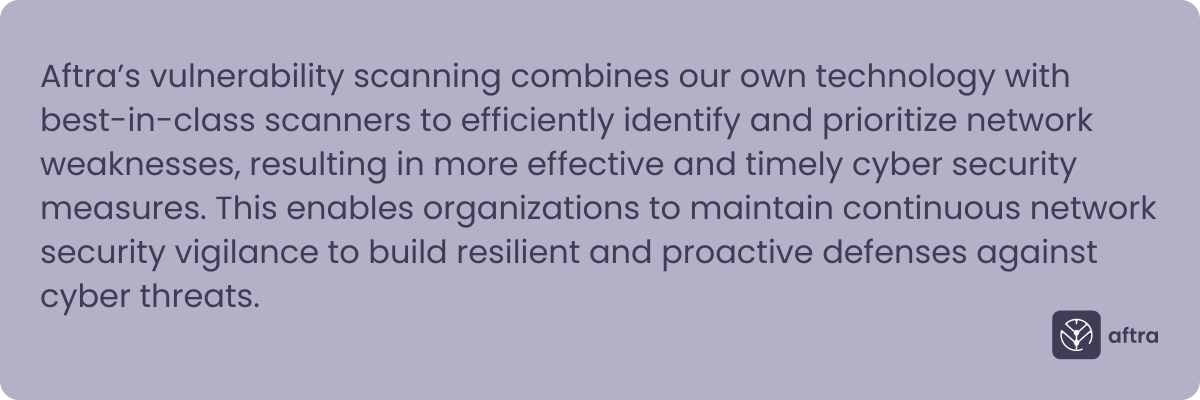
What Is Vulnerability Scanning?
As the term itself suggests, vulnerability scanning is the act of assessing your organization’s digital assets for potential security vulnerabilities that could be exploited by hackers for malicious purposes. Performing regular scans is an integral part of any cybersecurity strategy, because it helps shed light on vulnerable areas in your infrastructure. By understanding and addressing those potential weak spots, organizations are able to build a strong foundation for a robust cybersecurity strategy.
But vulnerability scanning alone is not enough. As the digital threat landscape grows, so must our defenses. Combining scanning with other vulnerability identification tactics such as regular audits, intrusion detection systems, security training, and external experts as well as adding in a thorough incident response protocol provides organizations with a solid understanding of their external attack surface. This minimizes the likelihood of security incidents occurring in the first place, while equipping companies with the resources to respond effectively if a breach does occur.
How Does Vulnerability Scanning Work and Why is it Important?
Vulnerability scanning is almost always performed via software, which examines systems, networks, applications, and other assets against a database of publicly known security vulnerabilities. It also reveals misconfigurations and out-of-date software.

Why is this so important?
The exploitation of security vulnerabilities is the second most common form of cyberattack just after phishing (IBM’s X-Force Threat Intelligence Index, 2024). And the first step to eradicating those vulnerabilities is to identify them. We cannot defeat that of which we are unaware.
But oftentimes it can be a challenge to detect these weaknesses internally. Familiarity with systems or a lack of security knowledge can lead to oversight. In the eyes of cybercriminals, however, vulnerabilities are like unlocked doors into your digital home.
Although vulnerability scanning is only part of the puzzle to understand your organization’s attack surface, it’s a crucial piece. It finds what humans can’t and their ability to efficiently identify and prioritize network weaknesses aids in more effective and timely cyber security measures.
Types of Vulnerability Scans
There are many types of vulnerability scanning and various vulnerability scanners available on the market today. Each serves a different purpose and which ones you use, depends on the specific needs of your organization. Some of the most common types include:
- External vulnerability scanning: External vulnerability scanning looks for weaknesses in an organization's public assets. This includes servers, networks, operating systems, databases, and applications. It scans for known vulnerabilities, such as outdated software, misconfigurations, or missing security patches that could potentially be exploited by attackers.
- Network vulnerability scanning: Network vulnerability scanning scans your internal network for potential security issues such as unpatched software, open ports, or weak network protocols.
- Dynamic web application scanning: Web application scanning identifies weaknesses in the application or exploitable patterns observed in the application logic.
Adopting a holistic approach to vulnerability scanning
Continuously scan and monitor
Most scans capture only what’s happening at the time the scan is performed. But new vulnerabilities are constantly being introduced or discovered. This means that continuous scanning and monitoring is critical to properly understanding your organization’s attack surface and protecting your assets.
It’s even better, if the scanner you choose has the ability to be constantly running in the background.
Choose the right scanner
So how do you choose the right scanner? To reap the most benefits from vulnerability scanning, we recommend a combined and continuous approach. Choosing a scanner which is dynamic and made up of many different types and always working to find potential vulnerabilities a hacker could exploit, sets your organization up for success.
The Aftra solution is one such example. It combines web vulnerability scanners and traditional scanners with our own unique scanner, which is always running in the background.
It not only scans for known vulnerabilities, but picks up on common mistakes in software that can lead to issues such as crashes, as well as known and common configuration errors. Mistakes in an application’s logic can unknowingly result in exploitable patterns in your software. In addition, it also checks if an organization’s domains are configured in a way that could be exploited by malicious actors. This can also reveal if similar domains exist that are used for phishing scams.
It’s also important to check for open ports in an application. Here at Aftra, we take that a step further and additionally fingerprint what kind of application or system is running based on a few different metrics. We can use that information to decide whether or not to perform additional vulnerability checks or more dynamic application scans.
In combination with all of the above, we also recommend that organizations perform network vulnerability scans, which Aftra performs through Nessus.
Combining Vulnerability Scanning with a Robust Cybersecurity Strategy
To sum up, vulnerability scanning enables organizations to get a better understanding of their weaknesses, but it doesn’t fix them. Combining it with a solid cybersecurity strategy will enable you to address the issues found in scans, minimizing the likelihood that an attack will occur, while equipping you with the ability to respond in the case that it does.
Discover Aftra
Interested in learning about how Aftra’s External Attack Surface Management platform combines continuous vulnerability scanning with real-time insights and monitoring?
Book a demo
